A Look Back at Great Moments in Texas Golf History
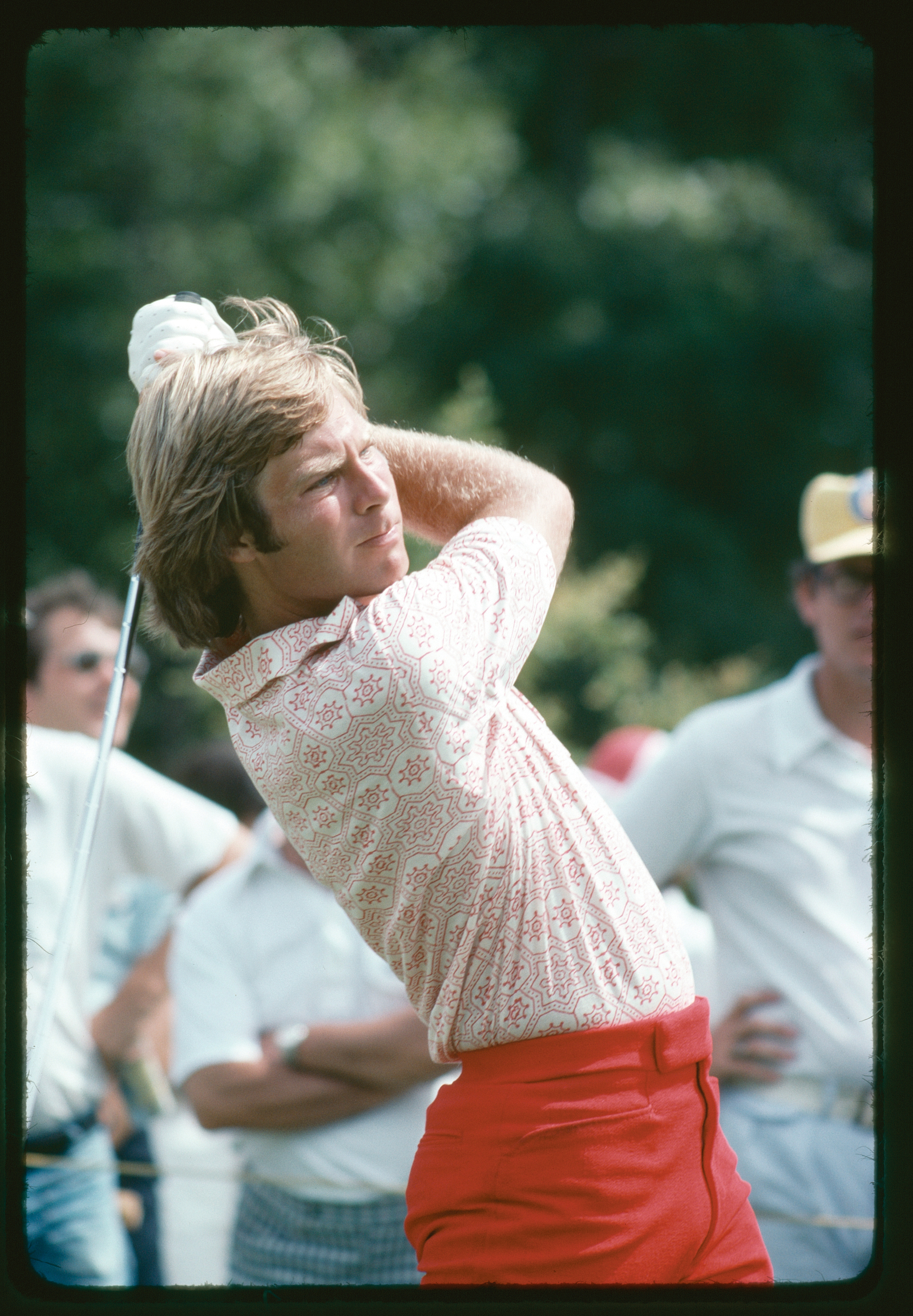
1959
Wesley Ellis Jr., 27, was a former caddie and decorated junior golfer from San Antonio. He studied zoology at The University of Texas, where he played for the legendary Harvey Penick, who wrote in one of his books that Ellis always seemed to select the right club at the right time. Ellis thought about going to medical school. Then he finished as low amateur in the 1954 Texas Open. He chose a go at golf instead.

An early advocate of a cross-handed putting grip, Ellis shot 276, eight under par, over a week of poor weather and muddy turf at Brackenridge Park, where he had played so many rounds as a boy he lost count. His score was good enough to win by two over Bill Johnston, who held a share of the lead on the 72nd hole as he helplessly watched his tee shot dribble into the river that hugged the edge of the green. Ellis won $2,800 of the $20,000 purse to nudge his season earnings above $6,000.
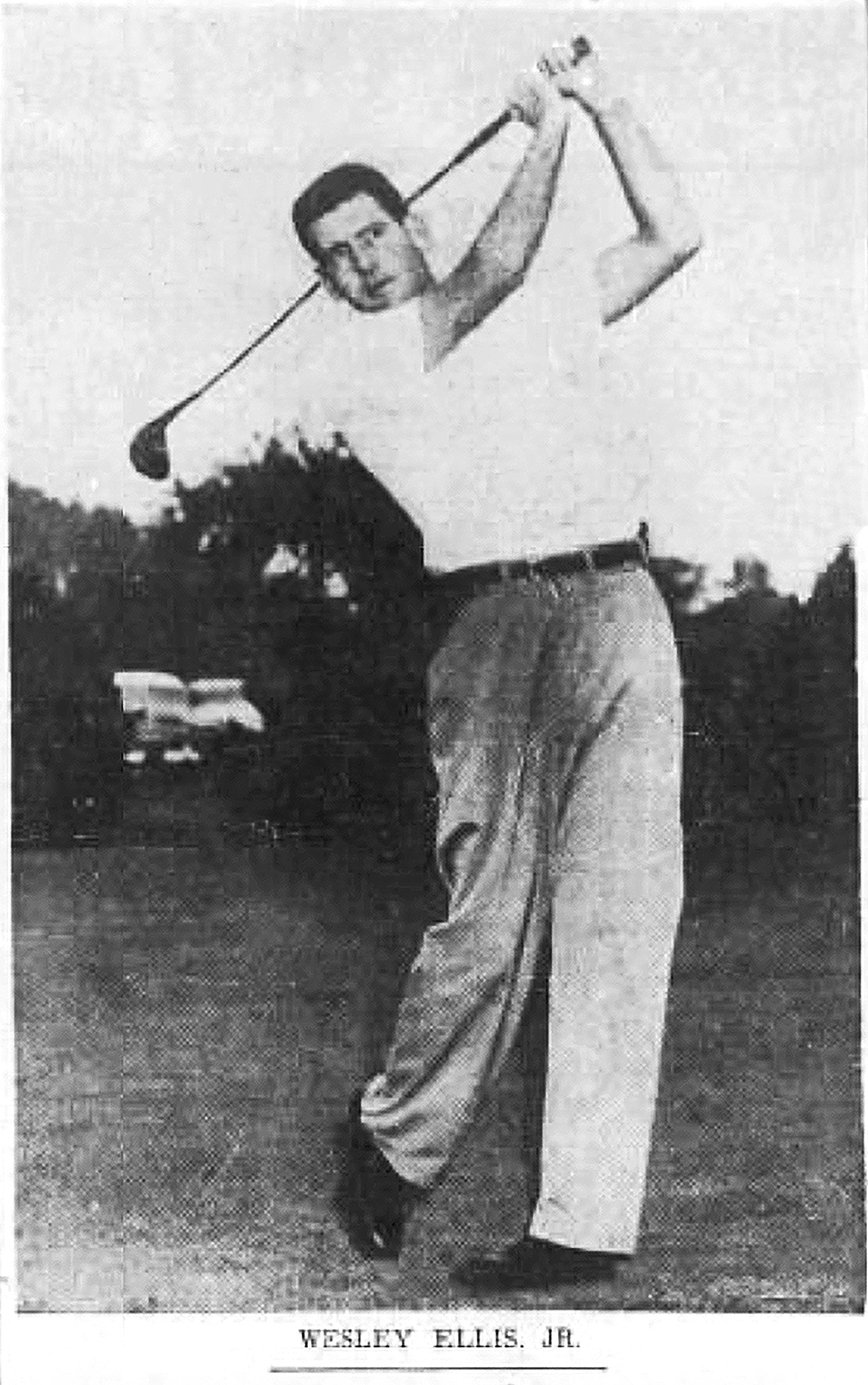
Johnny Janes, now the sports editor at the San Antonio Express, captured the sentiment of the city in his column a week later: “The San Antonio kid—it’s impossible not to still think of him as that, because I remember him as a young teenager playing the park course with his pet dog following him from hole to hole—has arrived as a golf star. Now watch him go on to greater success.”

That success was relative. Ellis won only one more tour event, the San Diego Open Invitational in 1965, to finish with three tour titles. But he captured a number of lower-level tournaments in the Northeast, where he augmented his livelihood as a teaching pro at, among other venues, Westchester Country Club in Rye, New York.

1973
In the spring of 1973, as organizers planned the 44th Texas Open, Ben Crenshaw won his third individual NCAA championship at The University of Texas. He decided after his junior year to turn pro. “The timing was right,” he recalled in his 2001 memoir, A Feel for the Game. Crenshaw had played in two U.S. Open championships and two Masters Tournaments as an amateur. He had made the cut in all four. His NCAA titles had granted him special exemptions to play in seven additional PGA Tour tournaments. He’d made the cut in those, too.
Crenshaw, ’73, Life Member, won the PGA Tour qualifying tournament in the fall of 1973 by a startling 12 shots. He announced that he would make his first official professional start at none other than the Texas Open.

Can you imagine a more anticipated debut? Here was Crenshaw, all of 21 years old, among the most decorated amateurs in the history of Texas golf, and the three-time college player of the year, choosing his home-state tournament as the launch of a career that seemed destined for greatness. Crenshaw already felt connected to the Texas Open. He had played in many Texas state junior championships at Brackenridge Park, winning the title in 1967, hitting off of the same mats that Ben Hogan and Byron Nelson and Sam Snead used. As the first week of November 1973 approached, Crenshaw placed the lucky putter he called Gentle Ben into the trunk of his car and drove the 70 miles south to San Antonio.
He did not disappoint. He shot 65 in the first round, 72 in the second. That weekend, Crenshaw commanded one of the largest galleries anyone had ever seen in 50 years of Texas Opens. He fired rounds of 66-67 at Woodlake to beat Orville Moody by two and George Archer by three. The newest face of the Texas Open, as fresh as they come, belonged to the youngest champion in the 50 years of its existence.
“This kid is going to be winning tournaments for many years,” tournament official Gordon Glenz told reporters.
“He has the same appeal that Arnie has,” said Moody.
“Ben has a great future ahead of him,” said Archer, the 1968 Masters champion.
1978
The Texas Open took place at Woodlake Golf Club through 1976, an era in which tournament proceeds would benefit Santa Rosa Medical Center at the rate of $2,000 to $75,000 a year until 1984. Terry Diehl won his only PGA Tour title at Woodlake in 1974, beating 1971 champion Mike Hill by one. A year later, Don January of Dallas birdied the first playoff hole to eliminate Larry Hinson. Butch Baird won the Texas Open in 1976 in another playoff with Miller Barber.
The tournament returned to Oak Hills in October 1977, a move that thrilled players and spectators, given the majesty of the golf course and its predictable conditions. Hale Irwin, a former Division I college football player, came to the Texas Open that year with 10 titles to his name, including the U.S. Open in 1974. He and fellow Austin resident Tom Kite, BBA ’03, Life Member, a teammate of Crenshaw’s on two national-championship teams at Texas, tied for the lead after three rounds.

Kite eagled the par-5 10th hole but made no birdies in his final round of 71. Irwin coasted to a 67 to win $30,000, a new Texas Open record.
“As I walked to the eighth fairway, I told my caddie I had to play four under the rest of the way,” said Irwin, who beat Miller Barber by two with a four-round total of 266. “And I did.”
“When you shoot a round without any birdies and you don’t have many great shots, you’re not going to have a very good round,” Kite told reporters. “Hale’s a good player and there are a lot of good players on the tour. But how would he have played if I had put some pressure on him?”
Kite would never find out. His third-place finish at Oak Hills would be the best he ever notched at the Texas Open. In the kind of curious coincidence that makes no sense in anything other than golf, Kite won 19 tournaments on the PGA Tour and 10 on the PGA Tour Champions in a World Golf Hall of Fame career that spanned five decades—but none of those in his home state.
Crenshaw, his childhood friend from Austin Country Club and former UT teammate, had no such misfortune. He’d won the Colonial National Invitation in 1977, his fourth tour title, before returning to San Antonio for the 1978 Texas Open. Now 26, Crenshaw arrived at Oak Hills in peak form. He held a two-shot lead after 36 holes. But it shrank to one after an uneven third-round 70 that included two bogeys and a double in his first seven holes.
“Gosh,” Crenshaw said Saturday night. “After just throwing away shots here and there, I felt like I was just committing suicide.”
Leonard Thompson and Lee Trevino were just a stroke behind when play began Sunday. So was Ron Streck, a young two-time All-American at the University of Tulsa who’d barely made the cut.
The gallery rooted openly for Trevino, the Dallas man who again had his spirits crushed at the Texas Open. Streck, 24, followed his third-round 63 with an 8-under 62 on Sunday, setting a new tour record for lowest total score in the last two rounds. He won $40,000 of a purse that had risen to $200,000 for the first time.
“I’m still a little bit in shock,” Streck told reporters after beating Lon Hinkle and Hubert Green by one and Crenshaw by two.
“The guy shoots a 63 and a 62,” Crenshaw marveled. “What can you say?”

1986
Weather again disrupted the 1985 tournament, when seven-time tour winner John Mahaffey found himself four shots behind young and winless Jodie Mudd with four holes to play. Mudd made bogey on the 15th. Mahaffey made a pair of birdies before his arrival at the 18th tee. A frisky wind blew at 15 miles an hour as he launched a piercing 5-iron shot to the last green. His ball stopped two feet from the hole.
“Birdies on the three of the last four holes,” Mudd said. “Unbelievable.”
Believe this: Mudd botched the second playoff hole from a greenside bunker. Mahaffey won the championship with a two-putt par. He hailed from Kerrville. It felt like a homecoming.
“It’s the first time I’ve won in Texas,” he told reporters. “And to win here in San Antonio—I grew up just 60 miles up the road and played a lot of junior golf here—this is something very special.”
Shortly after Mahaffey spoke those words, the PGA Tour announced that the R.J. Reynolds Tobacco Company had agreed to sponsor an elite season-ending competition at Oak Hills that effectively would replace the Texas Open in 1986. The so-called Vantage Championship would offer a purse of $1 million. It was scheduled for Oct. 23 through Oct. 26 as the last of 44 official money tournaments.
The development rescued the Texas Open. As it had in the past, the tournament struggled in the 1980s to attract the top players. The growing list of beneficiaries included the Handicapped Boy Scouts, Youth Alternatives Inc., the Bexar County Medical Center, Methodist Hospital, St. Luke’s Lutheran Hospital, and the Sunshine Cottage for Deaf Children. Annual donations had ranged from $10,000 to $32,000. The San Antonio Golf Association needed an impressive field to attract enough commitment from sponsors to support those causes and others. The reimagining of the tournament, organizers hoped, would bring big names back to San Antonio.

When Mahaffey won in 1985, the Texas Open included only five of the Top 20 players on the tour money list. For a golf tournament founded on the idea that more money meant a better field, the Vantage Championship seemed like a rewrite of the origin story. “Late fall tournaments have had problems attracting top players,” Jeff Byrd, an R.J. Reynolds spokesman, said at a press conference announcing the new sponsorship and format. “We hope our sponsorship will solve this.”
The Vantage Championship would give the PGA Tour the kind of compelling high-stakes finish in San Antonio that the Super Bowl gave football, the World Series gave baseball, the NBA Finals gave basketball. It was, in a way, the first generation of the FedExCup playoffs, which now crowns a winner at the Tour Championship after a season-long points race.
“I can tell you without reservation that we are absolutely delighted,” said tour commissioner Deane Beman, who had a special affinity for the Texas Open as its winner in 1969.
A sparkling list of 156 competitors entered the Vantage, which would award $180,000—nearly triple what Mahaffey and Peete had won in the two years before—for first place. Among them was former Texas Open champion Crenshaw, whose affection for Oak Hills inspired his best golf since winning the 1984 Masters.
He played early in the first round and shot 65. Then came the rain. Seventy-two players were stranded on the course when play was suspended. Trevino signed an incorrect scorecard. Tom Watson put a different putter in his bag before play resumed. Each disqualified himself as the skies cleared.
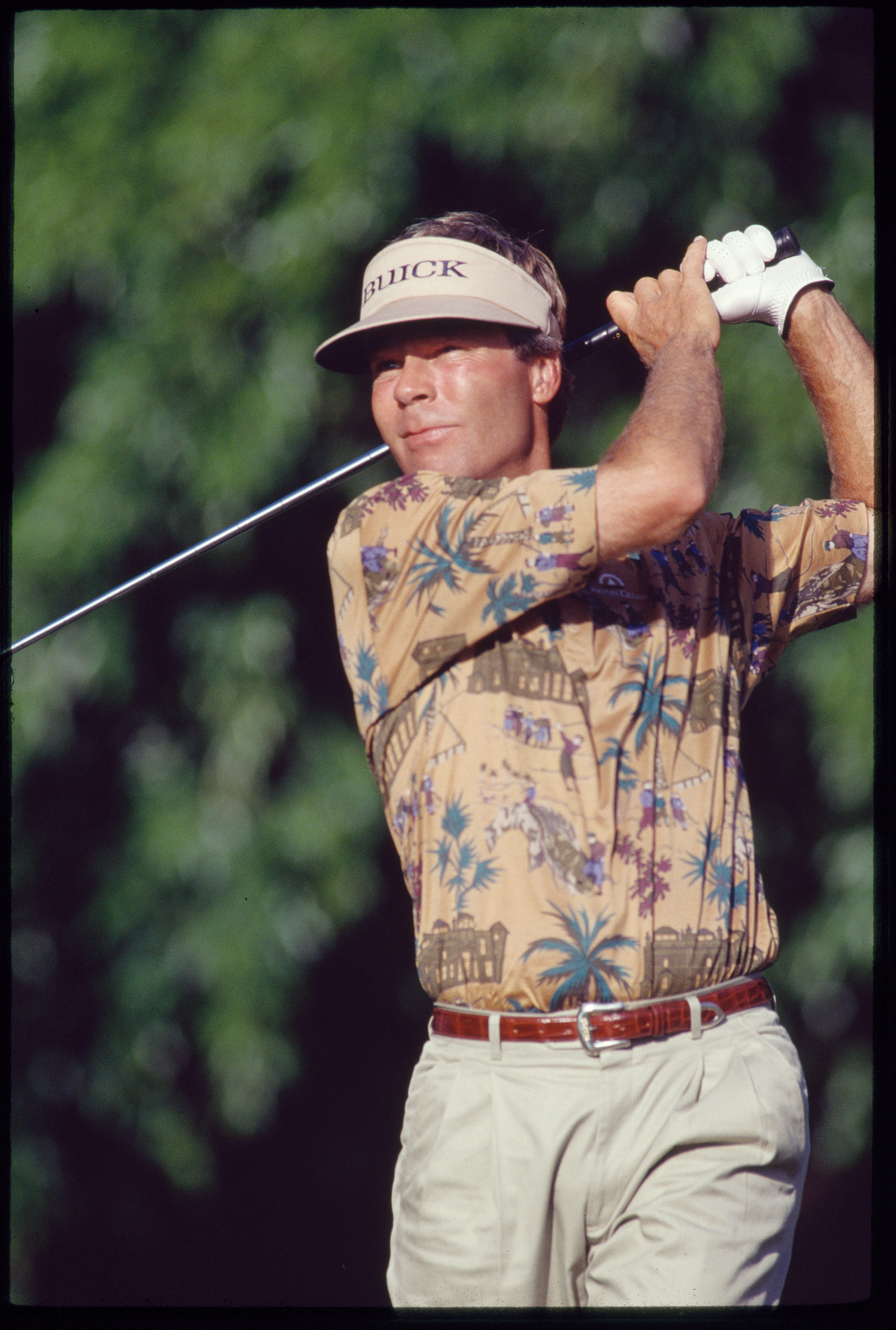
Known for his genial demeanor on and off the course, Crenshaw said he felt “fortunate” in winning the 1986 Texas Open after torrential rain forced the cancellation of the fourth round.
Crenshaw played well again in the second round. But Payne Stewart, the charismatic knicker-wearing Missourian who had 16 Top 10s that season, shot a 65 to tie him at 8 under. Five players, including Phil Blackmar of Corpus Christi, were a stroke behind Crenshaw and Stewart, who would play together in the 36-hole final round. For purists who appreciated long, elegant swings reminiscent of Golden Age players like Hagen and Jones, it was as good as it got.
“With 36 holes to go and on this course, anybody who tees it up tomorrow can win the golf tournament,” Stewart said.
Tensions rose Sunday with the drama unfolding over the first 18 holes. In an exquisite demonstration of golf, Crenshaw shot 6-under 64, Stewart a 65. They separated. They left Blackmar and the rest four impossible shots behind. Aside from the biennial Ryder Cup, Americans rarely got to watch live match play at the professional level. But that’s what the Vantage Championship had become. All present could scarcely wait to see what happened next.
“It was such a beautiful day,” Crenshaw said.
Then he said, “Rain was the furthest thing from my mind.”
But rain is what came again as the last round commenced. It was torrential. It was in the form of sheets. It was, to borrow from Mudd, unbelievable.
“Oh no,” Stewart thought. “It’s happening to me again.”
Stewart knew well the anguish of losing in extra holes in Texas. In the last three years, he’d lost twice in playoffs at the Colonial Invitation and once at the Byron Nelson Classic in Dallas. Stewart glumly added the Vantage to that regrettable list when officials made the decision to cancel the fourth round as rain continued to pound Oak Hills.
“I’ll have to live with it,” Stewart said.
“I’m the most fortunate soul around,” Crenshaw said.
1991
One of the big hopefuls in 1991 was Bob Estes, ’88, Life Member, the lanky and methodical college player of the year in 1988 and tour rookie of the year in 1989. Raised in Abilene and living in Austin, he was 123rd on the money list that October. He looked to be in decent shape after three rounds. He shot an even-par 70 on Sunday for a share of seventh place.

“Let’s see,” Estes said after his round. He calculated his earnings: $25,275. “That’s $133,000 for the year. That should be good enough.”
Estes, Loren Roberts, and Nick Price continued to play often and well in 1992, all of them looking for redemption at the elusive Texas Open. Estes had two Top 10s that season but remained winless on the PGA Tour. Roberts had enjoyed an excellent October, with finishes of second, third, and eighth.
Price had become a force. He had thirteen Top 10s in ’92. He finished in fourth at the U.S. Open. He won the PGA Championship, his first major. The four-time winner, fresh off of a third place at the Canadian Open the week before, came to San Antonio on a run in which he’d finished sixth or better in his last four starts.
It was more of the same brilliance at Oak Hills. Price shot 67-62-68-66. He’d trailed for much of the second round. Then he birdied three of his last four holes to force a sudden-death playoff with his friend Steve Elkington of Australia. Elkington had a 3-foot putt on the second hole. Price had removed his glove and begun walking to the next tee.
“It never entered my mind that he might miss it,” Price said.
Then he heard groans. Elkington did miss. Price had completed an October to remember. He became the fourth $1 million winner that season on a PGA Tour that offered purses unimaginable in 1922, when Bob MacDonald and Cyril Walker decided to give Texas a try, enticed by the $5,000 in prize money.
“I never thought I’d win a million dollars in a year,” Price allowed.
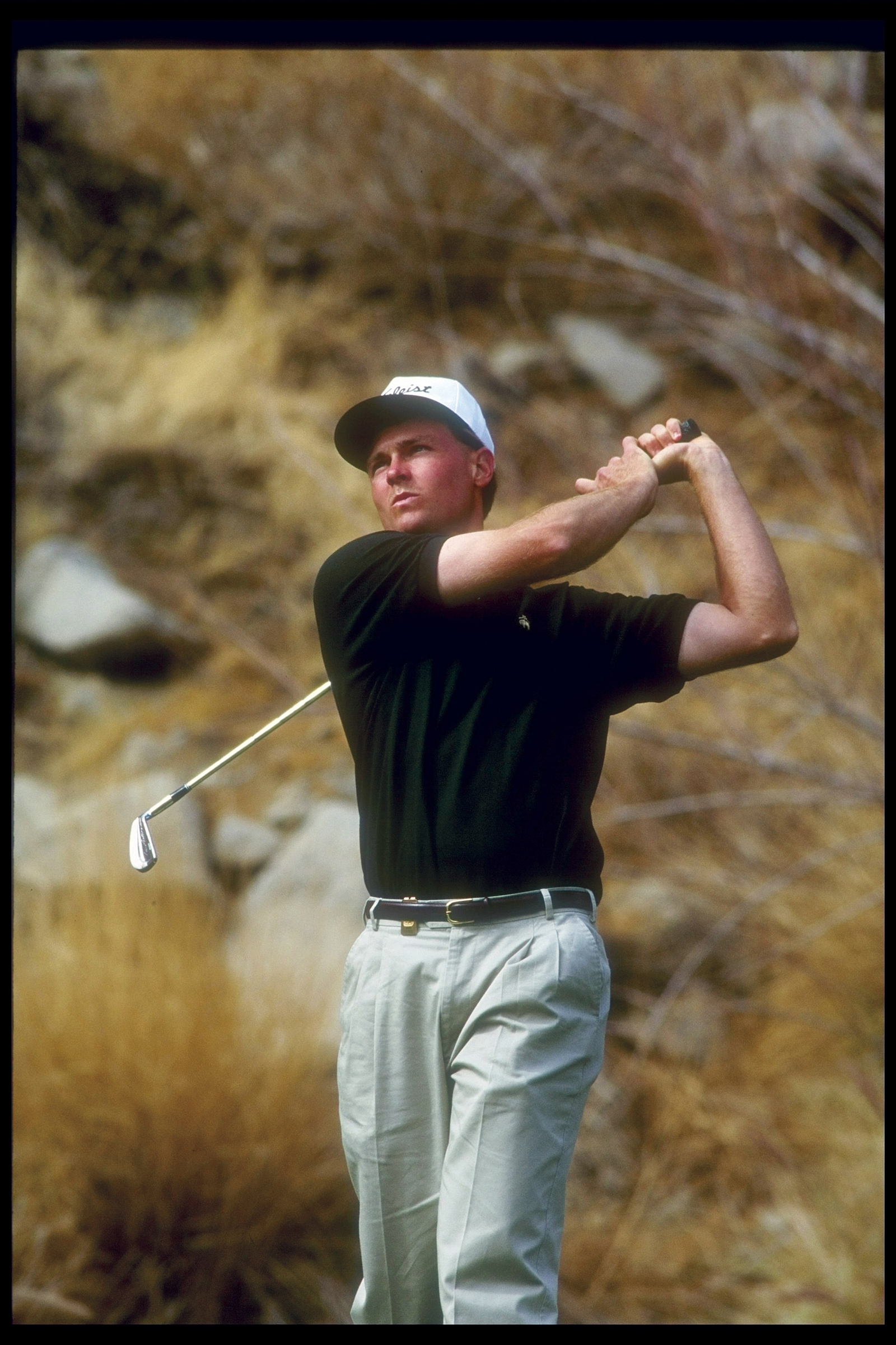
The 1993 Texas Open, with a first-place sum of $180,000, featured another close finish and playoff that, again, ended on the second hole. It also crowned another repeat winner.
Eleven years after winning the Texas Open in 1982, Jay Haas holed a slithering 25-foot putt on the last green of regulation to tie Bob Lohr. Haas won the playoff and the money: The San Antonio Golf Association had bumped first-place earnings to $180,000. Billy Andrade, who would go on to become the first tour player to win with the Pro V1 ball, finished in third.
Estes, as Texan as they come, got fourth place alone, five behind Haas and Lohr, another Texas Open entered and lost. It was good money for certain: $48,000 toward the Top 125 for 1994. But Estes was never really in it. Nobody except your family, friends, agent, and accountant really cares if you get fourth. Maybe next year.
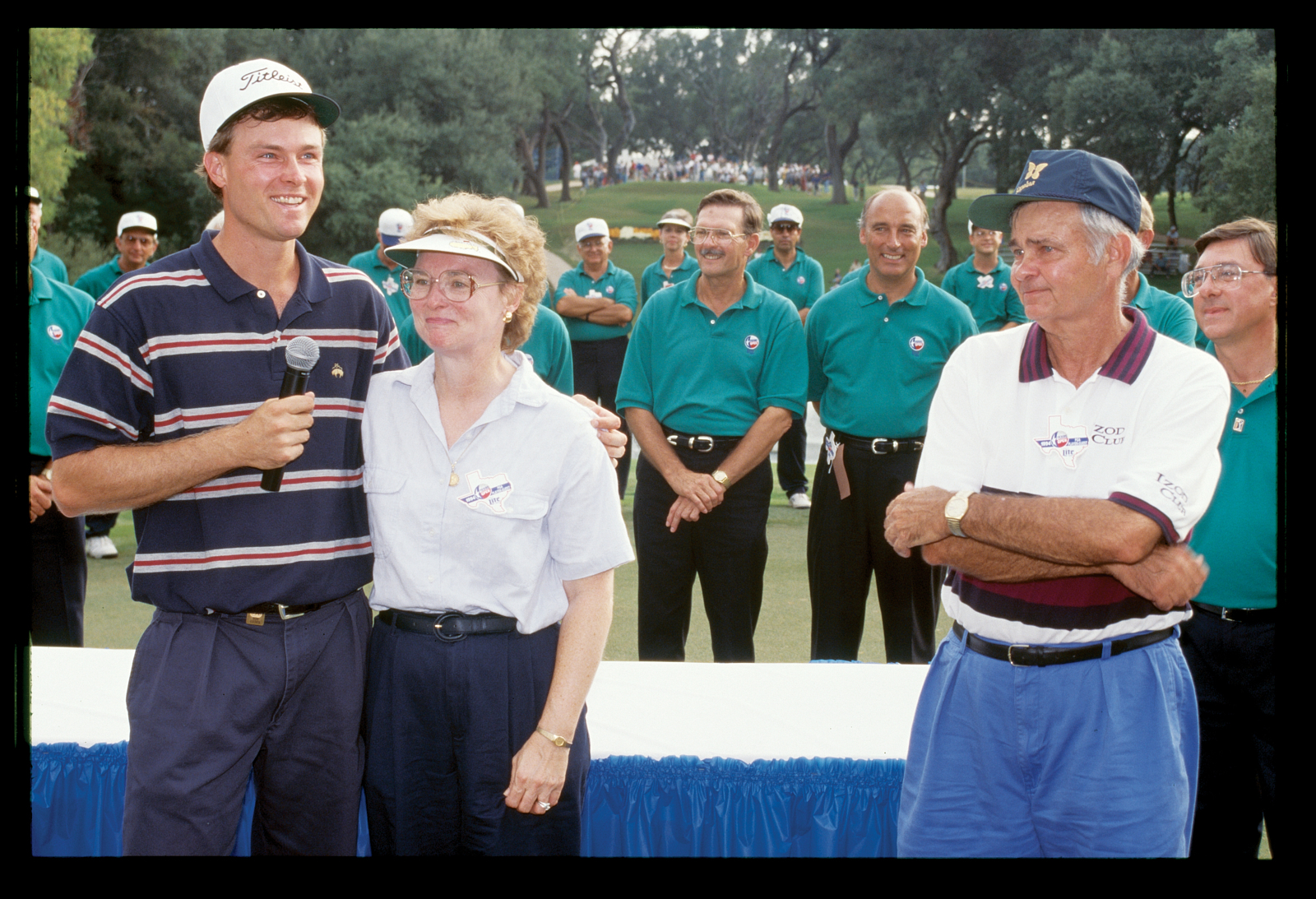
Next year: Estes shot 62 in the first round to take the lead. He shot 65 in the second to keep it. The $1 million 1994 Texas Open was right there for him, it seemed. Estes shot 68 on Saturday.
Estes still hadn’t won on the tour. He was 28 years old in his fifth season of professional golf. He was comfortable near the top of a leaderboard—in 23 starts, Estes had six finishes in the Top 10 and 15 in the Top 25, with only three missed cuts. But this was an altogether new situation.
“It was tough, sleeping on the lead every night, especially when you haven’t won before,” Estes said.
His 1-under 70 in the final round was all it took. Estes nipped Gil Morgan by one. He beat a raft of fellow Texans who contended, players like former Texas Open champions Blaine McCallister and Crenshaw. “I couldn’t pick a better way to win my first tournament,” Estes said before leaving Oak Hills for Austin.

It was the last time Estes, or anyone would play the Texas Open at iconic Oak Hills.
2000-01
The prize money kept soaring on the PGA Tour. By the time the field arrived in late September for the 2000 Texas Open, Tiger Woods had won all four majors at least once, foils such as David Duval and Phil Mickelson were rising to test him, and the networks and newspaper writers chronicled every new escalation in their emerging rivalries. Interest in professional golf had never been higher. No one could get enough of it.
A four-time winner on tour, Justin Leonard, BBA ’94, Life Member, rolled into San Antonio with a pair of second-place finishes in 2000 but no victories. His form was sublime that week at La Cantera, as good as it was at the 1998 Players Championship, his last win. The Texas Open was his from the moment he teed his drive Thursday on the long, bending par-5 first hole. He shot 64-68-65-64 to win by five. He earned $468,000. He had finally won a pro tournament in Texas.

“I don’t read a lot of golf magazines,” he said. “I don’t watch a lot of golf on television. But I know that I haven’t won in two and a half years. It’s like a little burden lifted.”
A year later, the San Antonio Golf Association and other tournament officials prepared for the Texas Open in the weight of national mourning. The tournament began two weeks after the Sept. 12, 2001, edition of the San Antonio Express-News published a picture on its front page of the World Trade Center towers in flames, under a large, bold headline that read “A NEW DAY OF INFAMY.” Activity hastened at the military bases in the city, as it had in previous periods of international tension. Reservists at the Brooks and Lackland Air Force bases were called up. Officials at Randolph, another Air Force installation, activated personnel. The terrorist attacks briefly chilled tourism in San Antonio as the country grieved.
The PGA Tour canceled its two events scheduled for the week after Sept. 11, including a World Golf Championship in St. Louis. The Texas Open was the second tournament to be played, right after the Marconi Pennsylvania Classic. Leonard returned to defend his championship with 31 starts since he won in 2000. He had some Top 10s, but nothing better than a tie for fourth in Houston. He shot a 64 in the first round.
Three afternoons later, after a 69 that beat J.J. Henry and Matt Kuchar by two, Leonard had become the first back-to-back winner of the Texas Open since Arnold Palmer. “There are a lot of motivating factors,” Leonard had said Saturday night. “I have a chance to win, and that’s it right there.” After he rolled in the winning putt and the cheers rose around the 18th green, Leonard tried to speak. He paused to cry.
“I wanted to say something about the patriotism I’ve seen this week,” he said, “and I just got choked up.”
Golf felt right in those last days of September at La Cantera. It was a small but real demonstration of unity and fellowship during a dark time in American history. Leonard won in front of his fans. Tom Kite won that week in California for the third time on the senior circuit. Texas and Texans had a good week in professional golf. It was time to plan for 2002, the 80th anniversary of the original tournament in the state and one of the oldest on the entire tour.
2007
Leonard missed the cuts at the U.S. Open, the British Open, and the PGA Championship, coming to San Antonio in the first week of October 2007 for a tournament he was not expected to win.
Earlier that season, the repeat champion in 2000 and 2001 had switched instructors. He left Butch Harmon and returned to Randy Smith, his old coach at Royal Oaks Country Club in Dallas. Their work resulted in a smooth scorecard all four rounds at the 2007 Texas Open: 65-67-64-65. Jesper Parnevik of Sweden, who led after three rounds, drifted to a 69, which tied Leonard. The two set out for extra holes, the first sudden-death finish at the Texas Open since 1999.
Leonard had a 1-5 tour playoff record. He rose above it. He halved the first hole with Parnevik. He missed a 5-foot birdie putt on the second. But he made one of 10 feet on the third.
And there it was. Leonard won $810,000 and his first title in two years. He became the first three-time winner at the Texas Open since Arnold Palmer.
“That’s pretty special,” Leonard said in his press conference. “There’s no better way to validate it than to come out and win a golf tournament like this.”
2015
Weird weather influenced scoring in the first two rounds of the 2015 Texas Open. Luck, good and bad, was involved. Some players fought nasty wind gusts of 40 miles an hour Thursday, when Dustin Johnson shot an uncharacteristic 78. The morning rounds Friday began in 40-degree temperatures, in which the typically steady Ryan Palmer shot a 75.
Walker got the good kind of luck. So did Jordan Spieth.
The two Texans were in the final group Sunday. They were the only two players in contention who had posted under-par scores in their first three rounds. Walker held a four-shot lead over the 23-year-old Spieth, who’d won his second PGA Tour title two weeks before at Innisbrook in Florida. A reporter suggested to Spieth that Walker would need to wilt in order for Spieth, ’12, to have a chance.
“I hope not,” Spieth replied. “I hope he plays well—and I play really, really good. I’m going to have to play a pretty flawless round of golf.”
Walker, in his own press conference, said: “It should be fun.”
Those words came from one of the most consistent players in golf over the last two seasons. Walker had won three times since October 2013, with impressive showings in the majors. He was a Top 25 player on tour in driving distance, birdie average, and scoring average. He was sneaky good. His young opponent knew it.
Spieth and Walker traded one fine shot after another. Walker’s lead was simply too much. Both shot 2-under 70. Walker won by four.
“Jordan, wow, he kept firing right at me,” Walker said. “It really showed what he was made of (and) what I was made of.”
Spieth rose to fourth from sixth in the world ranking the following week. His ascent had begun. The galleries at the Texas Open had witnessed the christening of a remarkable run for the relatable young star from The University of Texas by way of Dallas Jesuit High School. Spieth went on to tie for second in Houston the week after his solo second in San Antonio. Then he won the Masters the week after that. Two months later, he won the U.S. Open. Spieth tied for fourth at the British Open and took second alone at the PGA.
The christening would become a coronation. Spieth was the newest and brightest star in the game. The galleries in San Antonio could barely wait to see him win.
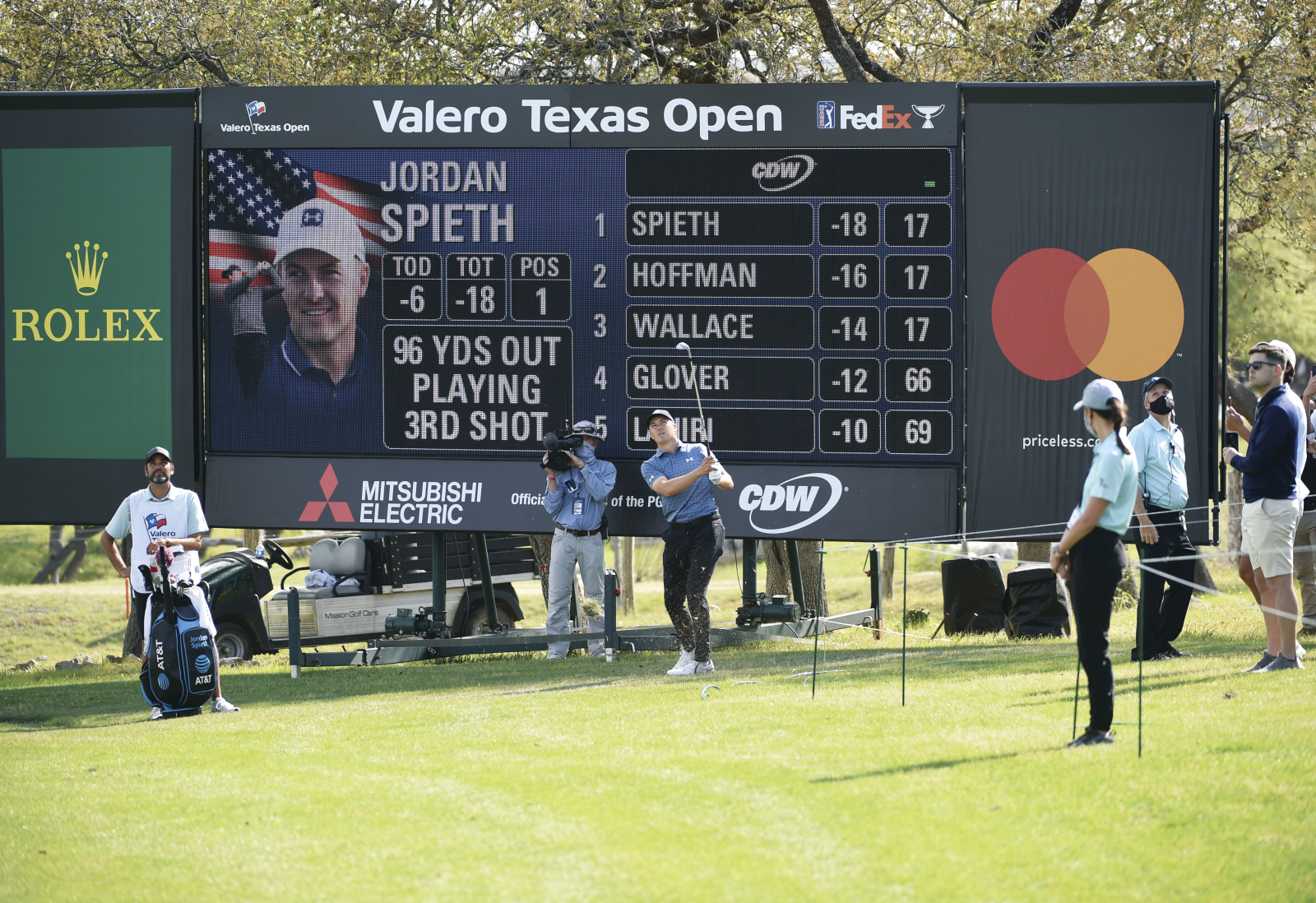
It wouldn’t happen in 2016. Spieth skipped the Texas Open, wedged that spring smack between the Masters and the Players Championship. Charley Hoffman, who tended to play well in San Antonio, made a 9-foot birdie putt on the 72nd hole to beat Patrick Reed by a shot. Walker missed the cut. It would be a distressing season for the defending champion until, in late July, he beat Jason Day by a shot in the PGA Championship at Baltusrol.
It wouldn’t happen in 2017, 2018, or 2019, either. Spieth didn’t even have a chance in 2020. No one did.
Spieth didn’t play the Texas Open in April of 2017. He had a sparkling season, though, winning three times and notching the third leg of the career Grand Slam at the British Open. Neither he nor anyone else had any premonition about what was about to happen next. Spieth didn’t win the Texas Open in 2018 or 2019. That’s because he would stop winning altogether. Just like that, the golf career of Spieth went from coronation to question mark. The galleries in San Antonio wondered if they would ever see him win again.
2021
Spieth explained after his second round at the 2021 Texas Open that he sought to feel “an artistic motion” when he attacked the ball.
He was, he told reporters in a remote press conference on a computer screen, “trying to work backwards.”
Corey Conners was too far behind to make a serious run at defending the championship he’d won two years ago. Spieth and Matt Wallace led after three rounds at minus 12. Hoffman, always a name to watch in San Antonio, chased them from two shots behind. The atmosphere crackled on Sunday at The Oaks. People staked out territory beyond the ropes and set up their chairs. They settled in for a day of golf and kept one eye on the leaderboard. Something special hovered in the air.
It had been 1,351 days since the 2017 British Open, when Spieth, now 27, had last won. That was 83 starts with nothing to show for them.
“It’s been a road that’s had a lot of tough days,” he would say in a matter of hours.
He spoke those words, tinged with both joy and relief, after a 6-under-par 66 to finish at 18-under 270, two shots better than Hoffman and four clear of Wallace. Spieth had won the Texas Open, his 12th victory on the tour, with a final round of seven birdies, one bogey, and the most cherished act in professional golf: marking his 1-footer on the 72nd hole so Hoffman and Wallace could finish, and the champion could make the last stroke and bathe in the cheers and roars and, when it comes right down to it, glory.
Cheers and roars did indeed erupt when Spieth canned the short putt in front of all those people watching professional golf again after a hard year apart. His wife, Annie Verret, ran to her husband, tears welling behind her sunglasses. Spieth lifted her from her feet and whispered in her ear. He felt a catch in his throat. The significance was lost on no one present. “It’s been a journey,” he told a television reporter next to the green.
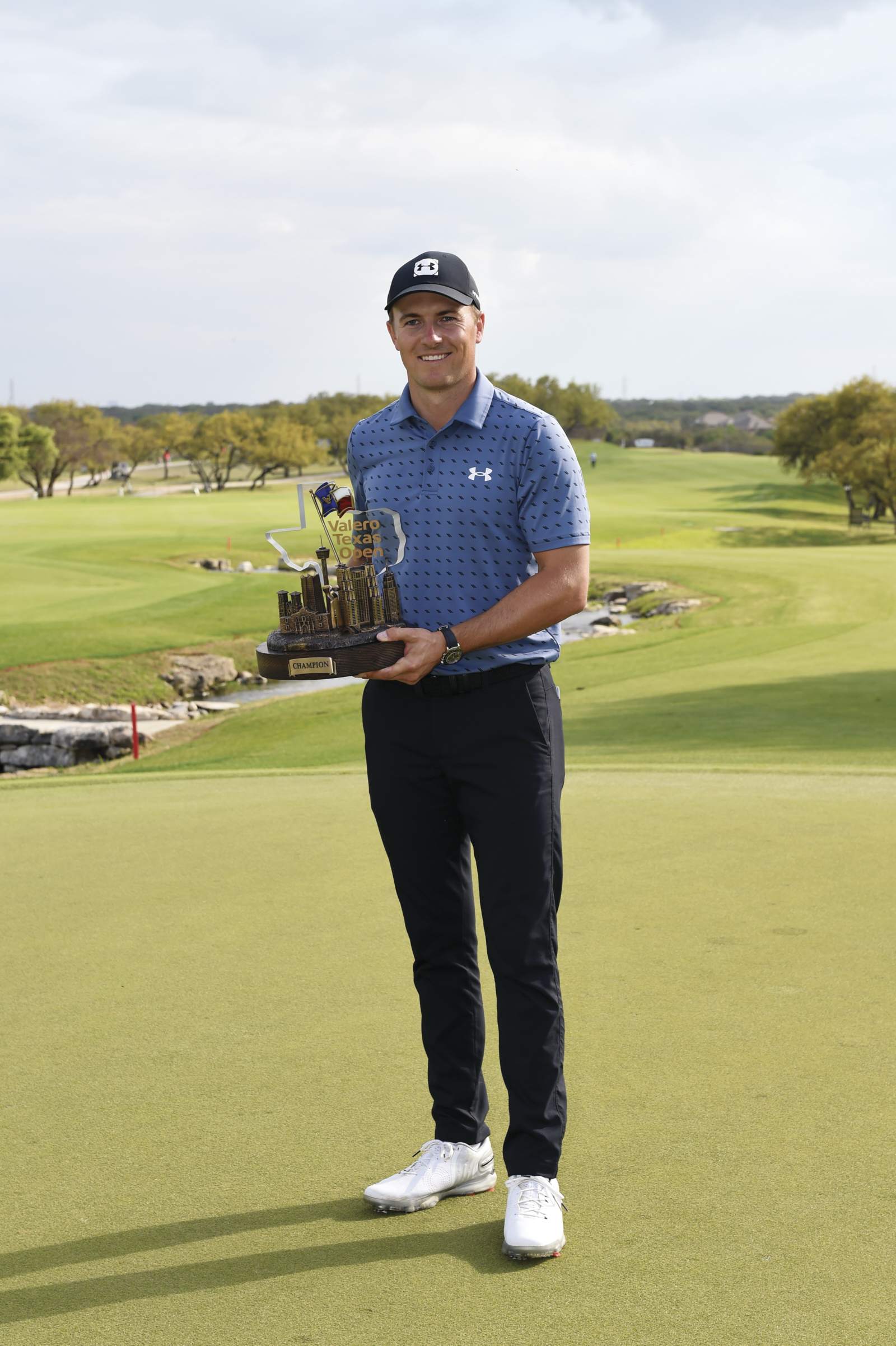
The Texas Open had produced another champion from Texas. This one was a redemption story. It was a comeback story. It was a story of validation and vindication.
It was, you could say, the story of golf: perseverance, trust, and luck—luck of the good kind. Spieth didn’t plan to win his first tournament in 83 starts in the state where he learned to play so well and went on to triumph at every level. That was just the way it worked out. His commitment to returning to the swing of his youth just happened to cinch the Texas Open. Think about that for a minute. Spieth broke a slump because he traveled back in time, recovered something from the past, and put it all together at the oldest and most historic tournament in his home state. Think about this: Maybe it took native soil underfoot to bring out the best in a popular Texan who needed something good to bend his career in the right way. It was, if you think about it like that, the kind of legend and lore Texas is known for.
That’s part of what we love about stories. Sometimes they end like you want them to.
“It’s about throwing out results and instead working on freedom,” Spieth said on that balmy Sunday afternoon in South Texas, the 4th of April.
“If I’m feeling freedom out there, I’m loving what I’m doing,” he explained. “And if I love what I do, I’m going to do it well.”
Just as 1922 felt like rousing introduction to Texas golf, this felt like the start of something, one more time.
Excerpted from the book It’s Been A Journey, commissioned by the Valero Texas Open, published in 2022 by Legendary Publishing.
CREDITS: Courtesy of the Valero Texas Open






